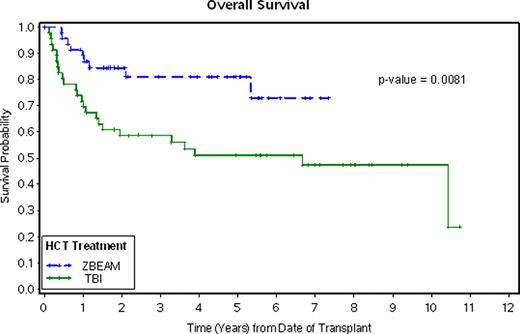Abstract
Abstract 32
RIT based conditioning offers the potential of combining the efficacy of radiation with decreased toxicity over traditional TBI. In pilot trials we demonstrated that combining Yttrium 90 (ibritumomab tiuxetan) with high-dose BEAM (ZBEAM) is feasible and has a toxicity profile similar to high-dose BEAM. Herein we report the results of a comparative analysis designed to evaluate transplant outcomes among DLCL patients who were conditioned with either ZBEAM or a TBI-based conditioning regimen. Patients were matched on age (+/− 5 years), disease status, number of prior regimens, year of diagnosis (+/− 5 years), and year of transplant (+/− 5 years). There was a total of 92 DLCL patients treated from 01/1997-01/2009; 46 patients in each treatment group. The median patient age was 56.5 years (range: 19–78) for the ZBEAM group, and 53 years (range: 21–62) for the TBI group. Both groups had a median of two prior regimens, with 13% (ZBEAM) and 15% (TBI) considered high-risk first remission, 65% beyond 1st CR and 22% induction failures in each cohort. The median length of follow-up for surviving patients was 51–83 months. There was a trend toward improved PFS in the RIT group: 2 year PFS for ZBEAM group 66% (95%CI: 56–74) vs. 50% (95%CI: 43–57) for TBI group (p<0.08). Results to date show that a plateau in PFS appears to have been achieved for both groups (at 2.6 years in the ZBEAM group and 3.7 years for the TBI group), which translates into a 20% improvement in PFS for the ZBEAM patients, >4 years post transplant. Similarly the OS estimate was significantly higher for ZBEAM compared to TBI controls: 84% vs. 59 % (p<0.01). The lower OS rate for the TBI cohort was primarily due to toxicity, with a 2 year non relapse mortality of 0% for ZBEAM vs. 13% for TBI. (p<0.01) The causes of death included: relapse progression n=9 (ZBEAM), n=15 (TBI), infection n=2 TBI, cardiac disease n=2 TBI, pneumonia N= 1 TBI, unknown N=3 TBI.
RIT based conditioning demonstrated improved survival when compared to traditional radiation based regimens in the treatment of DLCL due to a more favorable toxicity profile, while maintaining potent anti-lymphoma effects.
No relevant conflicts of interest to declare.
Author notes
Asterisk with author names denotes non-ASH members.



